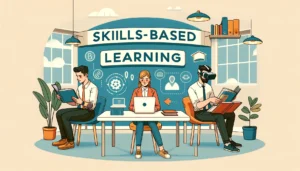Urgent hiring needs vs. long term business goals
- 7 Min Read
In this month’s regular column, Kay Cooper, Managing Director, RPO EMEA, Korn Ferry, discusses the competitive market of talent and the importance of finding the perfect fit when hiring for a role.
- Author: Kay Cooper
- Date published: Jun 25, 2019
- Categories

Businesses are currently experiencing a talent squeeze due to skills shortages. Combined with a need to fill positions much faster than ever before, organisations have to be much more strategic in the way they approach hiring to get the best results. Yet, finding a good candidate for the short term is not enough: any employee is an investment in the long term, and filling in gaps quickly often results in higher turnover and a process restart – negating the exercise in the first place. According to Korn Ferry’s latest research, 82% of hiring professionals say that when it comes to finding talent, it’s a challenge to meet current business needs while planning for long-term business goals.
Striking the right balance with finding the perfect fit for the job today and ensuring that there is a clear career path that turns each new employee into a long-term, loyal member of staff is crucial for business success. It is essential therefore that businesses are looking at the potential agility of candidates to adapt and change with their role and the business. Identifying what success looks like in a changing workplace can be a significant challenge, but by implementing a talent acquisition plan that aligns with long term business goals, companies can reduce any barriers to success.
So, what can businesses do to marry recruitment and organisational priorities?
Short-term hiring often occurs in times of disruption and change, which can stem from both inside and outside of the business. This can be from a digital disruption within the markets that the company needs to catch up on, by, for example, developing new channels to reach customers – from social media marketing through to turning customer support into an online chat or new e-commerce platforms. All of these require a specific set of skills that may not yet exist within the organisation. In fact, 77% of recruiters have said that they are hiring for roles that didn’t exist a year earlier, demonstrating how quickly demands can change. 57% of business leaders also stated that they are hiring for a specific set of skills rather than an actual role. This is because they are recognising the rapid changing nature of the world we live in and that a change in approach to talent management is needed to keep up with this.
In addition to the time pressure, the global growth of highly specialised industries has led to new demand for international candidates that can work in an international environment. While linguistic skills may not usually be included in the job description of roles in engineering, life sciences or manufacturing, they are becoming a more common requirement for many businesses that operate across the world. For these organisations, the challenge is no longer only to identify whether a candidate has the right competences for the role whilst aligning with the company’s values. Instead, they also to monitor the candidate’s language skills – a feat that puts more pressure on recruiting consultants to speak multiple languages themselves.
A higher demand in skills, such as languages, can make it more difficult for organisations to follow or implement a long-term acquisition plan. Yet, these plans will help them to anticipate short-term needs from the get-go as they prepare for the future and any unexpected changes. It is also vital that employers look internally at upskilling current employees so that they are able to step into new roles as imperatives shift. There will always be changes in business goals and plans but it is critical that organisations work to predict their future talent needs and either hire or retain existing employees to meet the challenges of tomorrow.
Plan, plan, plan
As the old age saying goes, failing to prepare is preparing to fail – and this is no different for talent acquisition. Despite this, many HR professionals and business leaders only prepare for short-term needs; 57% of those surveyed say that business leaders are only focused on immediate needs and 40% only forecast six months or less. This simply does not give organisations a long enough lead-time to align business goals, which are often concerned with a longer period of time, and talent needs.
Developing and implementing a detailed acquisition plan that looks at least one year ahead (the longer the better) will ensure that businesses are not blindsided by any short-term needs that crop up. Over one third of organisations who do this found that adopting a strategic workforce plan was the most effective talent acquisition strategy.
Talent acquisition plans should also ensure that businesses are tapping into all available talent pools, whether this be graduates, gig workers or those with career gaps. These areas have a wealth of potential candidates that organisations cannot afford to ignore. Gig workers in particular are a great way to solve short-term problems, and in fact nearly half of HR respondents say that specialised gig workers perform at a higher calibre of work on projects, and 46% say these employees actually save them money. Clearly, by building in the potential of the gig economy, companies can both solve short-term hiring needs while gaining expertise that otherwise would be lacking.
Disruption is set to hit all industries: from the rise of technological tools in the workplace through to faster time to market from the lab to the shop shelves, or even more stringent regulation impacting banks and R&D centres, organisations need to respond to the pace of change much faster and more strategically. A strong talent acquisition and retention plan will enable hiring managers to find candidates to fill immediate positions whilst keeping the future trajectory of the business top of mind.
People first
Part of the talent acquisition plan should look internally at current members of staff. Upskilling employees is not only a great way to deal with short-term problems, but also helps with retaining top talent. Businesses increasingly encounter the problem that roles are adapting and changing as technology develops, and employees need to be able to evolve with this. However, this is only possible if employers invest time into upskilling.
Business are already seeing the benefits of upskilling employees, with 61% stating that they would rather invest more in upskilling existing employees that recruiting externally, and when they do recruit, 61% also say that it’s more important to hire people who can adapt to changing business needs in the future vs hiring people who can fit immediate vacancies.
When staff feel as though they are valued, then they are more likely to success and help the organisation thrive. This is a seemingly simple solution, but over half of businesses still do not have training programs in place to respond to this need. With Millennials set to represent 50% of the workforce by 2020, providing a stronger feeling of purpose and career development path will become crucial – preparing today will prevent businesses from facing an exodus of highly skilled staff that they need to respond to in a short timeframe.
Final thoughts
90% of strategy is execution – and 90% of execution is people. Yet, HR is too often relegated to operations rather than a boardroom conversation. Short-term needs and changes can often dictate the momentum and direction of a business, but failing to look at the long-term impact of bad hiring decisions can have disastrous results for businesses: losing its best talent, facing a less than stellar employer brand, or underperforming are all immediate results from a lack of long-term hiring strategy. By connecting talent needs and business plans, organisations will be able to better prepare for the future and achieve their objectives.
Creating a detailed talent acquisition plan is key to this success. This should look both externally, at recruitment, and internally, at upskilling. This will ensure that the business is bringing in the right people at the right time, but also that today’s workers are prepared for tomorrow’s challenges.









